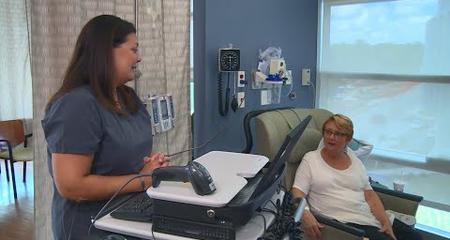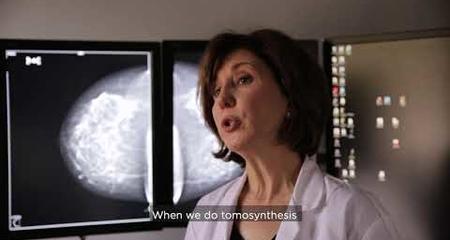 The goal of surgery is to remove all cancerous tissue from the breast and any cancer that may have spread to nearby lymph nodes. Our Breast Cancer Program includes a team of surgeons with advanced fellowship training in cancer surgery and breast surgical oncology. They collaborate with other cancer specialists to create the most effective treatment plan for each patient and work cooperatively with plastic surgeons to optimize cosmetic outcomes.
The goal of surgery is to remove all cancerous tissue from the breast and any cancer that may have spread to nearby lymph nodes. Our Breast Cancer Program includes a team of surgeons with advanced fellowship training in cancer surgery and breast surgical oncology. They collaborate with other cancer specialists to create the most effective treatment plan for each patient and work cooperatively with plastic surgeons to optimize cosmetic outcomes.
Breast-Conserving Therapy
Many women with early stage breast cancer are eligible for breast-conserving therapy (BCT). BCT consists of a lumpectomy (also known as a partial mastectomy or segmental mastectomy) followed by radiation therapy. Extensive research has shown that for properly selected patients, lumpectomy with radiation is as effective as mastectomy at controlling cancer.
Lumpectomy
During a lumpectomy, the tumor is removed through a small incision in the breast. To help ensure all the cancer is eliminated, the excision also includes a surrounding margin of normal tissue. Some breast tumors are so small that they cannot be located easily by feel. In these cases, the patient will first undergo a “preoperative localization” procedure in which a radiologist uses imaging guidance to place a small wire at the cancer site. The cancer surgeon uses this wire as a guide for removing the cancerous tissue.
Most women who undergo a lumpectomy are able to return home from the hospital on the same day. Radiation treatments typically begin within one month following surgery if chemotherapy is not to be given.
Mastectomy
A mastectomy involves removal of the entire breast, nipple-areolar complex and some of the skin of the breast. For some women, removal of all or most of the breast is the only way to safely control the cancer. Mastectomy is often required for women with a large tumor, more than one tumor or inflammatory breast cancer. In addition, patients who are not good candidates for radiation therapy are usually not eligible for a lumpectomy. Some women choose to undergo mastectomy instead of breast conserving therapy.
There are several kinds of mastectomy:
- Depending on the characteristics of their individual cancer, some patients are eligible for a skin-sparing mastectomy. In this procedure, the breast is removed through an incision around the areola (the nipple and areola are also removed) and the skin of the breast is left intact. The breast can then be reconstructed, either with an implant or using tissue from another part of the patient’s body.
- A nipple-sparing mastectomy is also an option for certain patients.
- A modified radical mastectomy consists of a mastectomy and removal of the lymph nodes under the arm.
Sentinel Lymph Node Mapping
When breast cancer begins to spread outside the breast, it tends spread first to the axillary lymph nodes (the lymph nodes of the armpit). For this reason, breast cancer surgery often includes the removal of these nodes. However, removing a large area of lymph nodes can result in a disfiguring swelling of the extremities (lymphedema) and other complications. The Breast Cancer Program offers sentinel lymph node (SLN) mapping, a technique that can allow breast cancer patients to avoid extensive lymph node removal.
SLN mapping can be an option for lumpectomy and mastectomy patients. It is offered when there is no clinical or radiological evidence that the patient’s cancer has already spread to the lymph nodes.
The procedure takes place immediately before surgery, or in some cases during the previous afternoon. First, a physician injects a radio-labeled tracer substance into the tissue around the tumor or near the areola. Next, a scanning procedure maps the movement of the tracer as it drains through the lymphatic system. The scan allows surgeons to identify the “sentinel” lymph nodes — the nodes to which fluid from the breast go first and in which any metastasis would first is appear.
During the breast cancer surgery, the sentinel nodes (typically one to three nodes) are removed and sent to pathology for immediate frozen section analysis.
- If cancer is discovered in the sentinel nodes, the surgeon proceeds to excise all the remaining axillary lymph nodes with the goal of removing as much cancerous tissue as possible.
- If the sentinel nodes do not contain cancer cells, it is safe to leave the remaining lymph nodes in place.
- The surgeon awaits the final pathology report to see if there are cancer cells present on close examination of the sentinel nodes. If cancer cells are present, the patient may need to return to the operating room for removal of the rest of the lymph nodes. If the final pathology report shows there are no cancer cells, there is no need for further surgery in the armpit.
When patients are properly selected, approximately two-thirds of women who undergo SLN mapping are able to avoid a complete axillary node dissection.
Mammograms and the COVID-19 Vaccine – What You Should Know
Swelling of the lymph nodes is a known side effect of the COVID-19 vaccine as well as other vaccines. Although it is temporary and not harmful, these enlarged lymph nodes may be seen on your mammogram. Because swollen lymph nodes can indicate breast cancer, we may call you back for additional evaluation and possible follow-up imaging.
Virtual Visits Are Available
Safe and convenient virtual visits by video let you get the care you need via a mobile device, tablet or computer wherever you are. We’ll gather your medical records for you and get our experts’ input so we can offer treatment options without an in-person visit. To schedule a virtual visit, call 1-866-680-0505.
More to Explore





